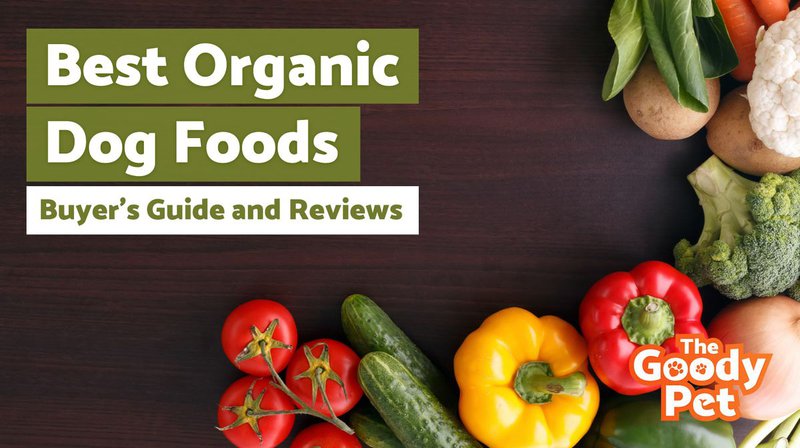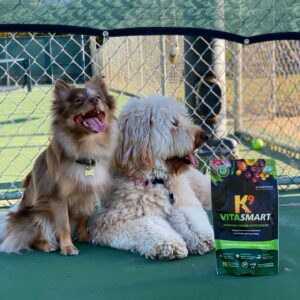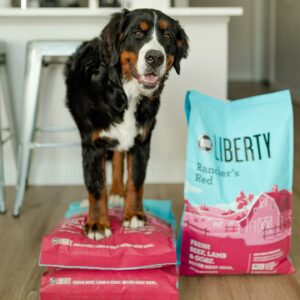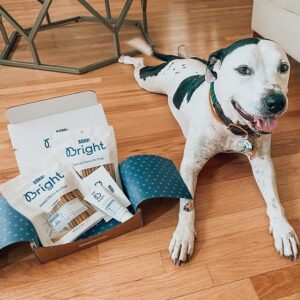The best organic dog food is Honest Kitchen Organic Dog Food.
If you have a pet pooch, it’s important to give them love, as well as a healthy and balanced diet.
There’s no shortage of dog food brands, but an organic diet is one of the best types of diet you can provide your furry friend.
The classification of organic dog food is much stricter – they should be free from additives, antibiotics, pesticides, and artificial hormones. Apart from that, the meat & vegetables used should also be naturally grown. Because of this, do expect to pay a considerable premium for organic dog food!
Here are 8 of the best organic dog foods in the market right now.
#1 Honest Kitchen Organic Dog Food
From all of the different organic brands, the best by far is Honest Kitchen. Honest Kitchen’s organic dog food is not only good for your dog because of its organic ingredients, but the company also understands the importance of using human-grade tools, so you know your dog’s food surpasses normal standards. The brand uses whole grains and vegetables and emphasizes its commitment to producing organic dog food by using free-range organic chicken and turkey, as well as ranch-raised beef.
The cooking process is very simple, as you just as have to add warm water for a hearty meal for your dog. Plus, this wholesome recipe is perfect for dogs of all ages, from puppies to active adults of any breed.
All things considered, the Honest Kitchen organic dog food offers your dog a healthy and delicious meal and gives you peace of mind. The high-quality organic ingredients make a wholesome recipe, and reliability for all dogs combine to make Honest Kitchen’s dog food the best on the list.
Pros
- Available in different bag sizes, with the 10-lb bag capable of making up to 40 lbs of dog food, and this makes this product affordable and ideal for your pups.
- It is made with 14.5 lbs of free-range chicken, which provides much-needed protein for energy and lean muscle.
- It contains five scoops of oats, which provide the organic fiber that helps with digestion and also has 2 ¼ bunches of carrots to provide vitamins and minerals for your doggie’s overall health.
- It is suitable for all doggie breeds in all life stages, and it is perfect for lactating or pregnant dogs.
- It is made of all-natural ingredients and does not contain by-products, GMOs, fillers, or artificial ingredients.
Cons
- Some doggies had to poop many times a day and ended up feeling lethargic and clingy.
- Some pups got hot spots and dry skin after consuming this dog food.
We vote this product to be the top pick because it is made with human-grade and AAFCO-approved ingredients, such as free-range chicken, organic fruits, and vegetables; plus, dog owners have the option of using it as their dog’s main source of food or as a dry food topper for adding flavor and boosting nutrition.
#2 Nutro Wholesome Essentials Dry Dog Food
If you’re looking for an organic dry dog food option that’s both beneficial to your dog and affordable for you, look no further than the Nutro Wholesome Essentials dog food. This dog food is made with delicious ingredients like farm-raised chicken, sweet potatoes, and brown rice, all organically produced to promote healthy skin, a soft coat, and overall good health in your dog.
Unfortunately, many of the essentials for your dog’s health, like vitamins and protein-rich foods, aren’t found in regular dog food, making organic dog food a must. For optimal health from the inside out, this dog food also contains Omega 3 fatty acids and vitamin E, which are essential for good health. Combine all of the health benefits with the extra benefit of saving money with this product, and it’s easy to see why it’s one of the best.
Non-GMO and clean ingredients are necessary for a healthy dog. The Nutro Wholesome Essentials dog food combines the best of both worlds for you and your dog. Your dog can enjoy organic and nutritious meals, while you enjoy a fuller wallet.
Pros
- This chicken and brown rice recipe is available in a 30-lb bag, and it is suitable for adult doggie breeds.
- The dry kibble is rich in protein, and this helps with lean muscle and energy for your pup.
- Contains essential antioxidants for body immunity and also fiber, which aids in the digestion of food.
- It contains omega-3 and omega-6 fatty acids, which help to give your furry friend softer skin and a shinier coat.
- This dog food is free of GMOs, soy, wheat, corn, or chicken by-product, which makes it safe for doggies with allergies.
Cons
- Some doggies do not like the taste or smell of this dog food and may take some getting used to.
- Some pups experienced vomiting and diarrhea a few days after eating the food.
#3 Ketona Chicken Recipe Dry Dog Food
Another great option is the Ketona chicken recipe dog food. This brand has all of the comforts of filling food, without the added artificial preservatives and artificial flavors. Unlike other products that claim to be grain-free, this organic product contains 75% fewer carbohydrates.
Instead, it supplements the overall nutrition with more protein that comes mainly from organic chicken, an astounding 46% to be exact. Your dog is sure to enjoy the delicious taste of ingredients like organic chicken, chia seeds, and coconut oil. These organic ingredients help build up a strong immune system and the digestive tract.
The Ketona chicken recipe is a great organic dog food brand because of its ingredients, but also because of its superb packaging, transparency, and quality. It’s definitely a good brand to try out.
Pros
- This product is a chicken recipe that is available in either a 4.2-lb or 24.2-lb bag, which is suitable for adult doggie breeds.
- It is grain-free and contains 85% fewer carbohydrates, and this helps with burning fat for pups that need weight management.
- It contains more than 46% protein, which helps with lean muscle.
- Contains other essential ingredients, which help to lower blood sugar levels as well as itching and skin irritation.
- It is made in the United States with all-natural organic ingredients and is free of GMOs and antibiotics.
Cons
- Not suitable for inactive doggies as it contains many calories per cup or serving, and it can make them sick after some time.
- It is not ideal for diabetic doggies as some of the ingredients can cause a negative reaction.
#4 Evanger’s Grain-Free Organic Dog Food
PFor a product that provides a truly unique taste for your dog, you can try Evanger’s grain-free organic dog food. This product comes as a whole cooked chicken that’s been lightly simmered. Evanger’s organic dog food is great for pets who are picky eaters because it’s made of only the best, free-range chicken. This organic recipe works perfectly for dogs who have sensitive pallets or stomachs, as it is grain free, having no fillers like soy, wheat, corn, or any artificial flavors or artificial preservatives.
Along with those reasons, Evanger’s dog food is also a good brand because of its transparency. You can easily find out what every ingredient is, and that’s why we love it.
Pros
- This dog food is available in a 12.5-oz can and is made of cooked organic chicken that is approved as Kosher by the Chicago Rabbinical Council.
- This is a climate-friendly product, which is free of GMO, wheat, or artificial ingredients, and it is packaged in a BPA-free steel can that is fully recyclable.
- It is rich in crude protein, which helps with weight management and lean muscle.
- Contains fiber for proper digestion and fatty acids for a shiny coat and healthy skin.
- Contains essential nutrients like calcium and phosphorus, which have health benefits for adult doggie breeds.
Cons
- Causes diarrhea and vomiting in some doggies with sensitive stomachs.
- Some pups take some time to get used to the taste.
#5 Castor & Pollux Organix Dry Dog Food
If you want something that’s tailored to your small dog’s needs, then you should definitely try Castor and Pollux Organix dog food. This brand is designed specifically for the little guy and has non-genetically modified ingredients like blueberries, coconut oil, and flaxseed.
These ingredients combine with several others to aid with digestion in both a pro-biotic and pre-biotic form. On top of that, Castor and Pollux value quality, so along with cooking foods in a certified organic kitchen, manufacturers also test before, during, and after production to ensure high-quality standards are met throughout.
The Castor and Pollux Organix dog food is a brand that surpasses standards for both dogs and their owners. Attention to organic ingredients and production, as well as thorough testing, are some of the reasons why it’s so great.
Pros
- This dog food is made with organic free-range chicken, which is ideal for small dog breeds, and it comes in a 4 lbs bag.
- It contains superfood ingredients, which include organic blueberries, flaxseed, and organic sweet potatoes, which are perfect for your pup’s overall well-being.
- Contains probiotic fiber, which helps with lowering blood sugar levels and digestion.
- It is grain-free and contains no antibiotics, chemical pesticides, soy, or artificial preservatives, which makes it perfect for pups with allergies.
- This dog food is USDA-compliant, which makes it safe for most small doggie breeds.
Cons
- Many pups pooped more than they ate, and this made them sick, dull, and lethargic.
- Some doggies vomited blood after eating this dog food.
#6 K9 Natural Freeze Dried Dog Food
A healthy option for dog snacks is hard to come by, not to mention an organic one. But the K9 Natural freeze-dried dog food is a great place to start because it combines great taste with organically produced ingredients. Made with lamb tripe, this product is served as a topper to your dog’s meal to increase appetite and facilitate better digestion.
As a true example of organic dog food, you’re only going to find lamb tripe in this product. It’s free of fillers, animal meals, artificial flavors, artificial preservatives, as well as GMOs.
This product is simple, yet delicious and nutritious. Your dogs are sure to love the hearty lamb addition to their meals, as well as the extra boost of energy.
Pros
- This dog food comes in a lamb green tripe recipe and is available in a resealable 7-oz bag.
- This is a grain-free organic dog food that acts as a daily supplement to support digestive health in adult doggies.
- Contains essential ingredients like fats, which help boost your doggie’s immunity while giving them healthier skin and coats.
- It contains proteins, which help with your doggie’s weight, lean muscle, and energy.
- It is free of GMOs, starch, legumes, and artificial preservatives, and this makes this dog food suitable for sensitive doggies.
Cons
- It has a strong smell that some pups do not like and will turn away from the food.
- It causes diarrhea and stomach discomfort in some doggies.
#7 Newman’s Own Dinner For Dogs
Newman’s Own Dinner for Dogs allows you to combine your love for your dog with a charity. The proceeds from your purchase go to an organization that works to connect dogs and people with disabilities. Besides the good you do for others, you also do a lot of good for your dog’s health. The chicken and brown rice flavors offer an organic recipe, without fillers like corn or wheat.
You can keep your dog on a healthy organic diet throughout their life with this product. From puppyhood to adulthood, Newman’s Own Dinner for Dogs is reliable and nutritious.
Newman’s Own Dinner for Dogs allows you to care for your dog’s organic diet, as well as the other people who need a dog to live comfortably with their disability. It’s a great combination of necessity and charity.
Pros
- This dog food is suitable for adult dogs and comes in an organic chicken and brown rice recipe in a 12.7-oz can.
- Contains fiber sources like carrots and flaxseed, which help with digestion and other nutritional needs.
- Contains some essential amino acids, which help with brain and heart health as well as boost your doggie’s immunity.
- It is corn and wheat free and does not contain artificial preservatives, and this is ideal for pups with allergies.
- This product donates 100% of its proceeds to charities, such as SeriousFun Children’s Network, Search Dog Foundation, and Fidelco Guide Dog Foundation.
Cons
- Some owners complained of smelly, discolored food once the can is opened, and this might not be safe for pups.
- Some pups experienced stomach upsets and bad breath after eating this food.
#8 TruDog Freeze-Dried Dog Food
Transitioning your dog from a “junk food” diet to organic isn’t easy, even though it’s naturally better for your dog’s health. This is where TruDog comes in. TruDog’s freeze-dried food takes the best part of raw meat and turns it into a portable dried snack for your dog. You can serve it as a topper or a significant portion of your dog’s meal.
TruDog is made with several raw organic ingredients like beef lung, beef blood, and ground beef-bone. Although these don’t sound appetizing, they combine to make a treat that your dog can’t resist.
You should definitely try TruDog’s freeze-dried food if you’re trying to get your dog on a raw diet. Even if you’re not, this is a great way to get an extra boost of health in.
Pros
- This product is freeze-dried dog food made of 100% beef and organs for adult doggies, and is available in a resealable 14-oz bag.
- It is minimally processed and made of natural proteins, all of which help with boosting energy and the development of lean muscles.
- It contains organic fiber that is essential for proper food digestion.
- Your pup can enjoy healthy skin and a shiny coat, thanks to its essential fatty acids.
- The product is free of corn, soy, and wheat, making it safe for pups with such allergies.
Cons
- It has a strong smell, which makes some pups refuse to eat this dog food.
- Smaller doggie breeds and other small pets need the pellets to be crushed into smaller pieces for easier digestion.
Organic Dog Food Buyer’s Guide
Every brand of dog food has its own focus, and even within brands, there are many options. Dog lovers can get confused with all of the different labels surrounding organic dog foods, but simplifying the buying process is as simple as learning more about the ingredients list.
Learn About The Different Labels
In order to supply your dog with the food they need, you need to learn how to read the labels on their food correctly. Let’s start by understanding what the difference is between products labeled “organic” and “natural.”
“Natural” Labeling
Starting with natural products, these are defined as those dog foods that don’t contain any synthetically made ingredients. Basically, anything that’s not made in a lab.
Even though this sounds like a good thing, it leaves a lot of empty room for things your dog doesn’t need. Your dog wouldn’t eat soy in the wild, but this is a common filler found in many dog foods because it’s “natural”. Natural dog foods are only a tad bit better than junk food kibble types.
“Organic” Labeling
On the other hand, “organic” foods are a totally different matter. The ingredients, processing, and handling of the foods are subject to strict regulation and inspection along the way.
Dog food labeled as “organic” means that the plant ingredients must be raised without any pesticides, genetic modification, or artificial fertilizers, while the meat portions were allowed to roam freely, ate organic feed, and were not treated with growth hormones. It’s easy to see why organic dog foods are so much better for your dog off the bat.
Without the added fillers, your dog truly gets natural foods as they would in the wild, all of which help them grow stronger and live longer.
On top of that, organic meats are free of antibiotics used to treat animals. Oftentimes, these can remain in the animal long after their death and get transferred to the consumer.
Similarly, GMOs and pesticides used to keep grains overly abundant are also harmful to dog health. These aren’t problems your dog has to face with organic dog food, however, such as antibiotics, pesticides, and GMOs are all strictly banned and monitored as a result.
So, while “natural” and “organic” food sounds similar, there’s a big difference between them that makes a huge impact on your dog’s health.

Ingredients Are Important
We all know that dogs need certain vitamins and minerals to help their digestive tract, as well as their outward appearance. The ingredients you have in your dog’s food directly affect their ability to live and thrive.
Better ingredients mean a better-lived, sickness-free, and longer-lasting life for your furry friend. It’s tempting to think that just because you buy organic dog food for your dog, that your dog’s food is 100% perfect. That’s not the case at all.
Read The Ingredients On The Label
The actual ingredients in your dog’s food, regardless of “natural” or “organic” labels, are what make up a good diet.
Think of it like this.
If you were to eat a whole tray of lasagna on your own, but it was organic, would it matter after you downed the whole tray?
Not really.
That’s the same thing with dogs. Though the ingredients, like corn and wheat, may be free of pesticides and harmful runoff from sludge, they still have little to no nutritional value for your dog. Taking a look at the ingredients lists and avoiding things like corn, soy, and wheat fillers is the first step in getting a more fulfilling diet for your dog.
Be As Specific As Possible
When looking for organic dog food, skip the fancy packaging and go straight for the ingredient list. Though the packaging should be labeled with “organic” or “natural” clearly, you can still double-check by looking at the ingredients. As a general rule, the more specific and readable the ingredients are, the more organic and better the product is for your dog.
Instead of just an ambiguous “meat” by-product ingredient, chicken or beef is a much better alternative. Paying attention to the labels and giving the ingredients a thorough comb through are both important to finding the best organic dog food.
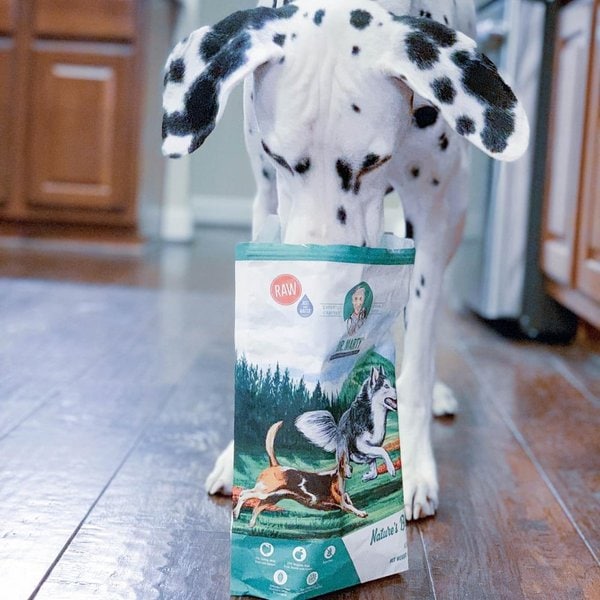
Understand Different Types of Organic Dog Food
Even among organically labeled dog foods, there’s a huge range of quality that you can find. Some foods are better suited for your dogs than others because of the level of organic material they contain. Generally speaking, there are four main types of organic labels you can find on a dog food pack, according to the USDA.
100% Organic Label
Firstly, you have a 100% organic label. This is basically the best of the best, as every ingredient in that can or bag has to be produced organically, except for water and salt. You should be able to pronounce every ingredient and the list itself should be small and minimalistic.
There shouldn’t really be too many fancy ingredients if it’s truly 100% organic.
Standard Organic Label
Next, you have the standard ‘organic’ label. This is what you usually find when you start looking for organic dog foods. These foods are made with about 90% organic ingredients. Usually, these labels include an asterisk or some kind of small print that states the non-organic ingredients or methods used. This is where it’s extra important to read the fine print because it may contain important information for your dog’s organic diet.
Made With Organic Ingredients Label
After that, you have the ‘made with organic ingredients’ label. This is when the manufacturers use around 70% of organic materials to make dog food. They still use a good amount of organic stuff, but some of it still can’t be labeled as organic.
Last but not least, you have the random organic ingredient in the list. You might see one or two organic components, like chicken or wheat, added to your dog food. Although this really isn’t organic dog food per se, it does have some benefits.
These types of dog foods are just a little bit healthier than your average kibble mix. Carefully inspecting dog food labels is important, as there are certain levels of organic ingredients.
Getting The Right Type Of Organic Dog Food
Just like any diet plan, there are many reasons people choose to switch their dogs over to an organic diet. Depending on your reason, you’re going to look for different types of organic dog food.
One of the reasons people switch their dog’s diet to a more organic one is for health benefits.
Oftentimes, dogs are sensitive to the fillers or artificial ingredients found in most dog foods. This can lead to an upset stomach or poor coat and nail health. Removing these types of artificial ingredients from their diet can positively affect their overall health.
In this case, you would need to focus more on the ingredients than the actual process of getting the dog food.
If you’re moving to an organic diet, look for minimal preservatives and colors, along with high-quality, single-source proteins. These are usually what help your dog’s health along.
On the other hand, if you’re looking for organic dog foods because you want to make a better impact on the planet, you would need to find a different type of organic dog food.
Organic farming is generally healthier for the earth because there are no harmful pesticides or fertilizers used during the growing process. This helps the earth, while also fueling your dog in a healthier way.
In this case, you need to look for brands that focus more on the preparation and upkeep of the earth during the dog food-making process. A brand that has this as its focus usually makes it very clear on the packaging.
Final Thoughts
Figuring out the best organic dog food for your friend takes some time. A good place to start on your dog’s organic journey is the Honest Kitchen Organic Dog Food.
This brand combines both organic ingredients and human-grade preparation, which really helps it stand out from the rest of the list.
Regardless of the specific brand you get, just remember to ensure that your dog is getting the cleanest ingredients in the most naturally occurring way.

